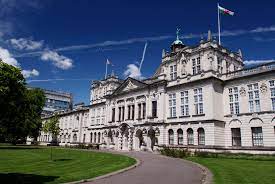Cardiff Lab Launches QUEST to Unravel Mysteries of the Universe
Researchers are seeking answers to some of the most elusive questions in fundamental physics at a brand-new experimental facility based at Cardiff University.
Harnessing technological advances in gravitational physics, the team of instrumentalists will explore the nature of space-time and dark matter and look for signatures of primordial black holes in an effort to learn more about the history and composition of the universe.
The bespoke facility will house a unique QUantum-Enhanced interferometry for Space-Time research (QUEST) experiment, built by the expert Cardiff team, alongside complementary gravitational wave instrumentation and prototyping equipment.
The new £1m cleanroom laboratory supported by the Wolfson Foundation and the Higher Education Funding Council for Wales (HEFCW), connects with an existing lab to complete a research suite where the team of experimentalists will expand their work developing and designing instruments for research in the field of gravitational physics.
Professor Hartmut Grote of the Gravity Exploration Institute based at Cardiff University’s School of Physics and Astronomy said: “The new labs will allow us to expand our work using precision interferometry as a tool to tackle unsolved puzzles in physics.
“These range from the quantisation of space-time and dark matter to what gravitational waves – tiny ripples in space-time – tell us about the history and composition of our universe.
The new spaces will be fitted with the hardware required to build and deploy instruments for experiments of this kind.
Using mirrors, lasers, sensors and computer chips, the team will build QUEST – two bespoke, high-precision, co-located laser interferometers that work together as one instrument.
Professor Katherine Dooley, also based in the Gravity Exploration Institute at Cardiff University’s School of Physics and Astronomy, said: “QUEST will test predictions of theories that attempt to unify the so-far incompatible theories of general relativity and quantum physics.
“We will search for signs of graininess, or quantisation, of space-time, that may be accessible to measurements via the so-called holographic principle.”
Cardiff University scientists made key contributions to the very first observation of gravitational waves in 2015 and subsequent detections thereafter.
Their research laid the foundations for how gravitational waves are detected, developing novel algorithms and software that have become standard search tools for detecting the elusive signals.
Since then, Cardiff University has expanded its expertise in experimental gravitational wave physics, appointing Professor Grote and Professor Dooley in 2018 and Dr Keiko Kokeyama in 2021.
Together, they offer an unprecedented combination of skills and expertise, bringing experience of designing, building, and commissioning detector instruments in three of the world’s four gravitational waves observatories: GEO600 in Germany, Laser Interferometer Gravitational-Wave Observatory (LIGO) in the US and the KAGRA detector in Japan.
Gravitational wave detectors consist of kilometre-long, L-shaped vacuum tubes through which a laser beam is bounced back and forth between mirrors, placed at opposite ends of each arm. Scientists look for signs of a gravitational wave entering the detectors by looking for a tiny mismatch in the time it takes each laser beam to complete its journey.
Dr Kokeyama, also based in the Gravity Exploration Institute at Cardiff University’s School of Physics and Astronomy, added: “Our work will inform the design of the next generation of gravitational wave detectors in Europe, the US, India, and in Japan, especially in researching new forms of squeezed light applications.”

